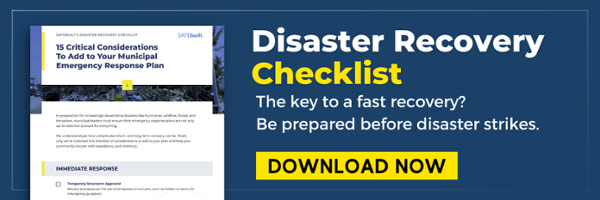In the wake of the ongoing COVID-19 pandemic, we are all reminded of what really matters in the face of national, state, and local disasters–protecting people. That will never change, nor should it change. It further reminds municipalities of all shapes and sizes of the importance of creating and maintaining effective disaster response plans.
What may often go overlooked in a time of crisis is the important role community maintenance can play in disaster response planning. Your community’s property and infrastructure are vital to an effective emergency or disaster response. In fact, they can act as assets.
For example, your local community maintenance program or department likely has the best handle and records on the current state of all municipal property, facilities, equipment, infrastructure, and anything else you’re responsible for keeping in proper working order.
You’re probably thinking, “…well of course–so what?” Consider for a moment the importance of pre-disaster geographic information system (GIS) inventory mapping in a disaster response.
GIS plays an essential role in a disaster management plan. For starters, it aides in developing mitigation plans based on vulnerability analysis mapping, and enhances preparedness through the development of evacuation zones and routes. GIS also supports response coordination using damage assessments to dispatch first responders (and their needed equipment), while also effectively helping recovery efforts through the comparison of pre- and post-disaster maps. It also essential in securing FEMA assistance. Your community maintenance information can give you the best chance to provide the best response with the best resources available.
It all goes back to keeping the citizens of your community safe and as unexposed to unnecessary risks as possible. The last thing you would want is to map out, say, an evacuation route along the most direct path, only to later realize one of the roads on that path was being re-paved, or was otherwise inaccessible, causing confusion, delays, or even more damage.
But that is just one smaller example, and disaster management plans are much more complex than that. However, it remains important to have this sort of information at the ready–before it’s too late.
There is no shame in gathering as much insight about such things as possible. In fact, it is highly advisable to consult with as many experts as possible for such a critical undertaking.
SAFEbuilt is a community development services company. We provide comprehensive building department, private provider, and other professional services with the goal of helping our customers build better, safer communities.


